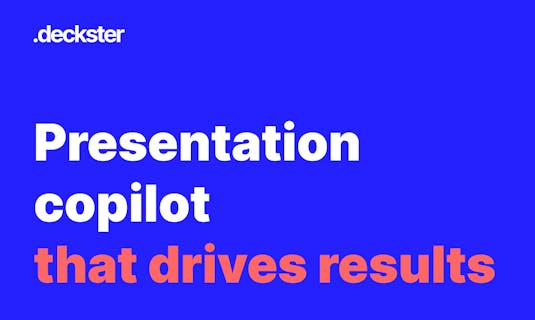Hello! What’s your background, and what inspired you to create Deckster?
My background is a bit everything, design, product, data & marketing. Last 10 years I’ve spent working on & for various startups, big and small. Ask.fm, Printify, Discovercars.com to name a few.
At some point, when I was 23, I attempted to launch a tours/workshop marketplace (right before the moment Airbnb experiences were released). Launching a full-scale marketplace as your first product was a bad idea.
Since then I have run a web dev agency, tried to launch another startup that again failed, and led product/growth/experimentation teams for a few companies.
While I’m successful at my day job, I have a dream to build a product that will help millions of people. And I will, a matter of time.

Speaking of Deckster.
I noticed a pattern. It doesn’t matter how much you work or how great are your tech skills. People who can talk and sell their ideas always win. Communication skills = Success.
People use presentations to pitch ideas, get resources, report, get feedback, etc.
But, most people suck at it, and so did I. I started to work on my skills, I improved and it worked. I’ve started to see more success and less resistance. It helped me, so me & my partner decided to help others.
Yes, there are 100 presentation makers, but they all focus on visuals and also ask you to leave your tool.
Deckster presentation tool is focused on structure & content & is designed for you to not leave your favorite tool.
Deckster helps you to get things done with presentations.
How did you identify the need for a tool like Deckster in the market?
- I started with the pain I had.
- I’ve skipped a longer research period this time (but I will use research as a marketing tactic later).
- I’ve deployed a half-baked tool in a few distribution channels.
- In the first week, we had 4 subscribers and around 20 sign-ups for a half-baked product.
- According to the probability theory:
- If there were 0 people with this problem we would not get any subscribers (or the message would be wrong).
- If there would be 1, or let’s say 100 potential customers we would probably also not see any subscribers, as they would be scattered across space.
- When you have repeated purchases in quite a short window it usually means that you either found all of your potential customers in one place, OR there are a lot of potential customers. We’ll see where we go.
How did you fund the development of Deckster in the early stages?
- Me & my partners time. We both are technical and I can do pretty much anything else.
- Moreover, we have a rule not to invest anything from our private $$. Why? This constraint motivates you to think better and be more creative.
What strategies are you planning to use to attract your first users and build an initial user base?
Right now the strategy includes four things:
- Manual outreach -> We will reach out to people for research interviews. People usually love research calls. If they like the product -> they start to use it.
- SEO -> That is a longer shot, but I’ve started early.
- Content -> We plan to distribute original content on Reddit, and LinkedIn.
- Aggressively improve the product. I do believe focusing on a great product is a marketing strategy as well.
Can you walk us through the process of creating a presentation with Deckster?
Sure, it’s better in a video format, which can be found here.
Long story short, the chatbot will ask guiding questions. Answers will be used as inputs to generate a tailored structure template for your particular use case.
Right now we only support 1 use case (Product manager | Pitch ideas).
How does Deckster assist users in keeping their presentations concise and to the point?
First, it creates an outline/structure for you. You can already use this structure to fill in your content. To make sure it delivers, we build Deckster presentation tool on top of a knowledge base from academic research, best practices, and our experience.
Second, it also teaches you on the go. It tells you what and why you should do to improve your communication next time.
What types of presentations is Deckster best for?
Right now we cover only 1 use case: ideas pitch for product managers. Next week we plan to expand the knowledge base for this use case and redesign templates to make it more useful. Then we’ll constantly expand use cases – OKR’s reporting, Hiring, Strategic plans, General pitch, etc.
What were the biggest challenges during Deckster’s development?
I would say compiling the initial knowledge base and designing the first templates. They do suck at the moment, but this is the first version. We know it’s the biggest value so we will double down there, before anything else.
What has been the most rewarding part of developing and launching Deckster?
Before launch, the fact that Deckster presentation tool was already useful to me at my day job. After the launch positive feedback from people.
Finally! Where can people find more information or resources about Deckster presentation tool?
There is not a lot now, but people can subscribe to my LinkedIn, I usually post everything there, including news and info about Deckster.
Did you enjoy this interview with Deckster’s founder? I regularly interview creators who have recently launched their products. Check out additional discussions like this on BetaHunt. For updates, follow me on X.

Leave a Comment